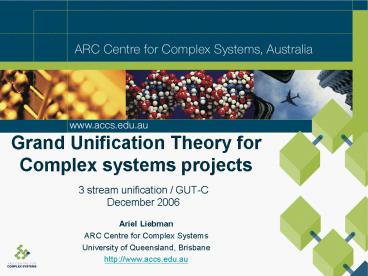Grand Unification Theory for Complex systems projects PowerPoint PPT Presentation
1 / 5
Title: Grand Unification Theory for Complex systems projects
1
Grand Unification Theory for Complex systems
projects
- 3 stream unification / GUT-C
- December 2006
Ariel Liebman ARC Centre for Complex
Systems University of Queensland,
Brisbane http//www.accs.edu.au
2
General Complex Systems Concepts and Properties
- Properties of System
- Large number of component ( gt 2)
- Network implicit! (or explicit) as the
representation of the structural map of
interactions between components. - Controversial statement 1 Network theory is NOT
complex systems theory. But it is one of the key
tools for it. - Multi-scale such as space scale, time scale, and
organisational/hierarchical level scale effects
are essential - Properties of components
- Nonlinear response
- Response timescales
- Variable connections to other components
- Useful views of systems
- Aggregation level (zoom level) Can apply both in
space and in time. - Self organisation and open systems
- Energy flow or its analogue (e.g.
aircraft/passengers in ATC) - Self organised criticality
- Exergy and Entropy
- Information theoretic measure of complexity
(Shannon Entropy, Kolmogorov Complexity)
Benard Cells
3
Looking for commonalities among the 3 streams
- Questions
- How do we find a commonalities between the
streams? - It appears that currently the level of detail of
each node in the network is different for each of
the streams preferred level of description
hence - Different levels of network detail
- Different levels of node detail due to
aggregation levels - For a common approach we may(?) need to aggregate
to roughly the - same number of nodes (within an order of
magnitude) - Similar network statistics (same power in the
power law?) or same type of network (scale free
or small world)
4
Looking for commonalities among the 3 streams
(Please fill in!)
5
Reading List
- A non-exhaustive reading list for us to get
started with - ACCS All Hands Day 2006 Presentations
http//www.accs.edu.au/index/AllHandsDay06 - John Foster 2005 From simplistic to complex
systems in economics - Ben Amor, Lavallee and Bu Percolation,
Pretopology and Complex Systems Modelling
(Complex Systems and ATC). - Yaneer Bar-Yam Dynamics of Complex Systems
(1997), Full text is available as pdf on
http//www.necsi.org/education/programs/dyn-fullte
xt.html. Particularly Chapter 1. - James Kay 2000 Life as a self-organising
holarchic open system - James Kay Thesis Chapter 3
- James Kay Thesis Chapter 6
- James Kay Thesis Appendix 1 Hard core
thermodynamics hesis - Schneider and Kay Life as a manifestation of the
second law of thermodynamics

